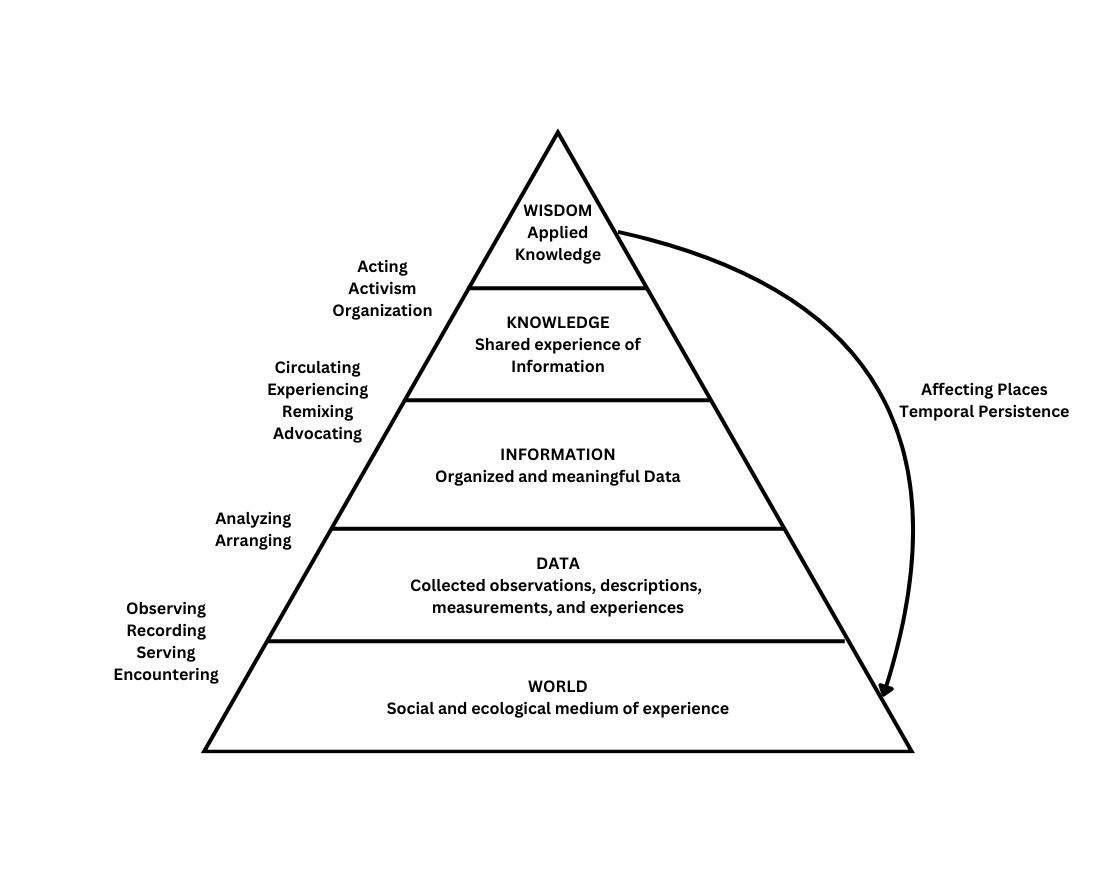Rhetorical Information Theory
Patrick Love
Rhetorical DIKW Pyramid
Recontextualizing the DIKW pyramid around rhetoric prioritizes concern for change, mobility, and justice that reflects present and future justice and sustainability (Aristotle, 2007; Edbauer, 2005; Hinks, 1940; Gries, 2015). It also builds metalanguage for students entering DIKW driven fields, particularly in science, technology, engineering, and math (STEM) wherein these concepts are gateways to dealing with human (and humanities) issues. The DIKW pyramid exists, in part, to rationalize how machines can process human experiences of the world, so metalingual ways to interact with these terms benefits humanists while maintaining their disciplinary concerns (Kelleher & Tierney, 2018). Furthermore, engaging with DIKW helps rhetoricians and compositionists re-engage with what "knowledge" means to people with other concerns, whose knowledge-making experiences are shaped by the ecology of circulation platforms and technology (Gunkel, 2009). Therefore, a rhetorical rendering of the DIKW pyramid would transform it from figure 1 to reflect the recursivity and futurity (connecting past, present and future) that rhetorical inquiry encourages, like in figure 6.

Figure 6's Rhetorical DIKW pyramid treats the rhetorical relationships between each level ecologically (that is, affecting each other across time and location) rather than as a linear process foregrounding necessary reduction for one to become the level above it. There is no hard rule about how “long” one level needs to last, like how sometimes we follow predetermined plans and take reflexive, situated action as our lives demand or allow. This pyramid aims to reflect daily life's messy interactions rather than assume all knowledge-production is a clean, laboratory-driven process, similar to the shift from rhetorical situations to rhetorical ecologies Edbauer (2005) argues for and the productive "trouble" that comes from recognizing recursivity is part of human experience (Law, 2004). This pyramid employs more verbs to emphasize the plastic and movement-oriented nature of rhetorical inquiry (i.e. navigating imperfect information) while resisting docility as a requirement. Circulation theory deals practically with the way 21st century communication revolutionized experience-sharing, but it also provides precedence for understanding that recursivity is inseparable from knowledge labor (going back to check premises or update assumptions, for example).
Information Theory avoids assuming that humans set out to make purposeful wisdom, implying it is always emergent and distributed, meaning a machine can accomplish the same labor apolitically. The logic at work implies humanity has innocently (maybe luckily) produced the world's current state because it is the best possible, or that our traditions and laws result from a higher wisdom we are pragmatically actualizing. Both visions imply conservative bias by holding the past as a standard. In one sense the "status quo" we feel is a reflection of the most prevalent knowledge. Socially and ecologically, a great deal of suffering is also perceptible in everyday life. Rhetorical DIKW emphasizes the choices and labor necessary to originate knowledge and emphasizes the skills students need to develop while machines automate portions of the labor. Thinking about wisdom as a purposeful and lasting product also highlights that we can choose to repair asymmetry and ecological damage (or not). Technology is arguably inalienable from rhetoric and writing, so Rhetorical DIKW emphasizes the skills that combine human and machine labor without investing in a particular technology's vision of writing or rhetoric, maintaining these acts as negotiation between human and machine for specific purposes. What's left to explore is how generative AI and Rhetorical DIKW interface with each other and fit into this rhetorical pedagogy.
